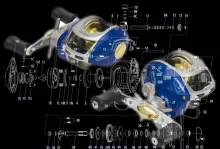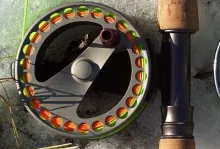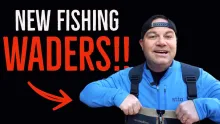Martin had a tremendous fly reel breakdown this past season! Upon returning from a fishing trip he did one one the rare maintenance rinses of his LAW-reel, and noticed that the small rubber tube holding the ratchet had cracked. Disaster!
I had a tremendous fly reel breakdown this past season! Upon returning from a fishing trip I did one of the rare maintenance rinses of my LAW-reel, and I noticed that the small rubber tube holding the ratchet had cracked.
Disaster!
I had to remove the tube and the little screwdriver-like piece of metal inserted into it. No little metal thingamajig means no sound from my reel. And a silent fly reel is not a real fly reel in my eyes... eh, ears...
The LAW
Some of you might be familiar with British reel and vise designer and manufacturer Lawrence Waldron. Lawrence is one of those uncompromising types, whose gear is on par with and in most cases far better than anything you bump into.
Lawrence has made various fly fishing related products: reels and fly tying vises plus a small assortment of other things like tools for bamboo rod makers. He still makes vices and produces one in cooperation with Snowbee, but his reel production as stopped.
I bought one of his reels many, many years ago, and it's the single best fly fishing purchase I have ever made! I have no precise date on the purchase, but my e-mail archives reach back to the beginning of 1995, and in a mail to long time friend from Colorado, Sue Kreutzer, from that year I talk about a picture of the reel, so it's older than that.
That makes the reel older than 15 years. I know that 15 years is no age for a good piece of mechanics, and that Pflueger Medalist, Abel and Tibor owners can probably brag about reels much, much older than that, but in my gear collection 15 years is a century, and considering the way I have treated the LAW-reel, it's amazing that my first breakdown is a rotten rubber tube.
Come think of it, that is not entirely true, because one of the handles cracked and had to be repaired a few years back, but more on that later.
The reel
Let me take this opportunity to introduce you to my reel.
My LAW reel is a black anti reverse reel with a diameter of 75 millimeters or about 3 inches. Anti reverse means that the spool can turn without the handle following it. The handle is in other words not turning when a fish is running.
The reel basically consists of three parts: the casing, the spool and the handle. This overall simplicity was what drew me to the reel in the first place. Its exquisite workmanship, beautiful look and overall precision were also reasons that I turned my head in Lawrence's direction.
I was introduced to the reels by Dutch Hans Weilenmann, and I think it was during a fishing trip to Germany that I handled a LAW reel for the first time - and fell in love.
Hans demonstrated his reel to me like I have demonstrated mine to so many people since: The owner holds the reel and a person in the audience is the fish.
He or she grabs the leader, plays the role of the fish and runs by pulling the leader.
The reel holder is playing the role of the angler and will brake gently by pressing the handle or the screw that holds it and the fish is smoothly brought to a halt. The makeshift fish makes a sudden move and the angler lets go of the handle, and allows the fish to run again. While all this has been going on the handle hasn't moved. Now the angler grabs it and starts reeling in the fish.
Whenever it makes a sudden move he just releases tension on the handle and allow it to run. If he wants to brake the fish completely he either presses hard on one handle to increase friction or gently on the other handle to engage the clutch that completely blocks the spool. He can at any time let go of either to let the fish run again.
Neat!
I have done this many times, and when all the oooh's and aaah's have been uttered in the crowd, I screw the reel apart by turning the handle knob - which moments ago was a brake knob - remove the handle and let the spool fall into one hand and hand these three, seemingly simple parts over to the "fish".
Most people will be - like I was the first time I saw this done - amazed by the simplicity, and start looking for intricate break, bearing and clutch parts, sprockets and springs and all kinds of mechanics.
But none are to be found.
The key to the fantastic operation of this reel is simplicity and precision.
Four surfaces
There are in essence four surfaces in the brake on the reel. One in the bottom of the reel cage, two are found one on each side of the spool and the last one is on the back of the serpentine handle.
When you assemble the reel, you drop the spool into the cage and the two inner brake surfaces meet. The you screw on the handle and the two outer surfaces meet. The tighter you twist the handle knob, the tighter the basic brake setting is.
By adding further pressure on the knob, simply by pressing it, you brake harder. You can also press the handle, which will skew the whole assembly slightly, also increasing the brake power.
If you let go of the handle or the knob, you are back at the basic setting.
Thanks to simplicity and precision, this is very easy to control, and a drop of oil on the brake surfaces about twice a year followed by a wipe over with a cloth, will keep it smooth and very accurate for a long time.
The famous test where you let the reel "crawl" slowly down the leader by its own weight only, is performed with excellence by my Waldron even after all these years. It will descend slowly and smoothly with no variation go until it gently hits the floor.
Custom made
When I ordered my reel, I was asked what size I wanted, and I remember replying that I just needed a reel that could take a WF 7 line and ample backing.
"Yes, but what size is that? In millimeters? Diameter and width...?"
What? I was somewhat befuddled. I had no idea, but upon inspecting my other reels I landed on 75 millimeters in diameter and 40 millimeters in width - that's about 3 inches Ø and 1½ inches across.
Considering that this is an "old fashioned" small arbor reel with a small diameter axle, that gave me more than enough room for a bonefish 9 weight line and several hundred yards of backing, but I haven't regretted my choice since. It has been a perfect size reel for me.
Reel engineering and design
I've heard many people say that Lawrence's reels are kind of old fashioned and heavy.
I couldn't agree less!
If I ever saw a timeless reel design, this was it. You need to look to Abel and Tibor to see similar designs, and calling such reels old fashioned is like calling a Porsche 911 or a Omega Seamaster old fashioned.
Sure, they don't look like Waterworks or Loop reels, but altmodich? Far from it!
Weight
When it comes to weight, it's true that my LAW reel is heavier than my Waterworks ULA, but compare to other reels of similar mechanical heritage, and the story is quite different.
My LAW reel weighs in at 218 grams or 7.7 ounces with a full line and about 250 yards of backing.
An Abel anti reverse reel close to 4 inches in diameter is 9.4 ounces or almost 270 grams without line. It's larger than my LAW, but also much heavier. If you select lighter Abel reels you can get down to about 5 ounces or 140 grams for a 3 inch reel without line.
A Tibor Billy Pate rated for a 7-8-9 weight is 8 ounces or almost 230 grams empty.
A Danielsson L5W 6nine for a 6-9 weight line is 192 grams with no line.
In comparison my Waterworks ULA weighs 170 grams or a mere 6 ounces with a full line and probably about 50-75 yards of backing.
Personally I have always thought that reel weight (or lightness) was a vastly exaggerated factor in reel assessment.
Most people seem to want a lightweight reel out of sheer reflexes rather than based on what compromises might be made to obtain the low weight. And also, most reels considered really lightweight aren't that light at all. The only really light reel that I know is the Waterworks ULA with no brake. That is slightly more than 100 grams or 3.7 ounces with no line in a 6-7 weight model, and that is really light!
But as soon as you add a bit of mechanics, a 3 inch reel will land in the 180-200 grams ballpark for the light ones, and even heavier for the stout ones.
So at 218 grams fully loaded my LAW is not heavy.
Large or small arbor
Most contemporary reels are large arbor, and some are really large like the latest Loop reels. The most current trend is V-arbor, which are spools that aren't flat in the bottom, but kind of grooved or V-shaped as the name indicates. You will find such reels in Bauer's Rogue reel, Loop's Opti and Lamson's Vanquish models. The Waterworks ULA had this facility years back where an extra capacity spool with a V-groove could be bought as an extra.
Large arbor reels have advantages, mainly the ability to pick up line quickly and having low startup inertia due to the large diameter, even when the spool is almost empty. The V-arbor reels have the same advantages, but generally offer more capacity.
The old fashioned small arbor reels like my Waldron have a huge line capacity and essentially become a large arbor reel when filled with backing - at the cost of some weight of course. If a small arbor reel isn't too narrow, the effective diameter will stay the same until a lot of backing is removed. I think I have about 2-300 yards of backing on my LAW reel and a shooting line and a shooting head on top of that.
Personally I love large arbor reels such as the Waterworks, Danielson LW and the Okuma Helios, but I have no problems with the Abels, Tibors and LAW's of this world with small spindles and very good line capacity for the size. If such reels are well made - and these brands are - there is no problem with brakes sticking or startup inertia. Time has more than proved that they work.
Back to my clicks
I dropped Lawrence a word about my rubber incident, and soon after a bag of new rubber tubes arrived. I now have tube for the next 45-60 years if the break down rate is the same as until now.
The repair took two minutes and required no tools, and I now have a nice clicking sound when I reel in and when a fish runs - if I want. Because the clicker is just that: a clicker. It has no other purpose and can be disengaged with no other effect than silence. The small rubber tube is mounted on a slider, which can be moved just enough to remove it from the sprockets on the spool. Once removed, there's no sound. The reel works just as before, but is silent.
Reel love
I have seen a lot of reels in my many years as a fly fisherman, and some really good ones too.
Sure I wouldn't mind fishing with a Derek DeYoung painted Abel reel or a Charlton reel, not to mention the astonishing Megoff titanium reels.
I do fish with a Waterworks ULA, which I find is one of the most innovative and ground breaking reels of modern times. Another favorite is my trusty Okuma Helios workhorse, which is in many ways quite ordinary, but a ridiculously inexpensive reel for the quality that it offers. It's vastly underrated because of brand snobbery if you ask me. My Swedish Bringsén anti reverse salmon reel is also a piece of art in itself as is my small Lamson Litespeed, which I use for a lot of my stream fishing.
All these reels are great, but I do far most of my fishing with the Waldron, which has caught countless specimens of my home water's sea trout as well as Swedish pike, Pacific salmon and Carrebian bonefish. It has worked flawlessly on every occasion, and is definitely the reel love of my life.
And if one of my sons or possible grandchildren, a niece or a nephew or any other upcoming fly angler in the family wants to inherit it once I'm not fishing any more, it will do as well for them as it has done for me.
As I said in the beginning: Lawrence doesn't make these reels any more, so this is no review as such. The reels were a lot of work to make, and Lawrence has chosen to concentrate on the vice business, which I fully understand, because I have one of his vices too. Need I say that it is the vice love of my life...? But that's a whole other story.
More reels online
If you are into reels, there's a couple of great resources out there.
First and foremost French FlyReelMania, which has links to almost all fly reel manufacturers - contemporary, discontinued as well as antique. There is no text about the reels as such, but the overview over more than 400 reel manufacturers is fascinating, and you can spend a lot of time just clicking around.
JustReels is a little more specific and a lot more in depth with its reels, mostly because they are for sale. Each reel model is described in detail and the reel is shown in pictures. If you want a Charlton a Bellinger or a Bogdan, this is a good place to look. Prices aren't low, but the reels surely are nice.
- Log in to post comments



































I have a leeda reel
I have a leeda reel thats about 25 years old and Love the design and handling of the reel.
And it still works pretty good, just started to get a little rust problems.
Have been searching for the same reel for a couple of years, and would really want a simular reel but with a good, slow brake system.
Hi
I know Snowbee
Hi
I know Snowbee reels - I have Geo Fly reel and for me this is the most advanced reel in the best price you can buy. It is absolutely perfect fly reel. Especially Geo # 3/4 and his 122 grams of weight. Next size (my own) has 128 grams only. For me this is the best LA reels ever.
Nice job Martin! I
Nice job Martin! I think I'll go fondle mine straight away.... :-)
Shannon,
I guess
Shannon,
I guess you mean the XS reels?
I never tried or even handled the Snowbee, but as far as I can see they are cartridge reels, with one spool and exchangeable cartridges, which is a system I personally never liked. I have seen it on Leeda and Scierra reels and it looks much better on paper than it is in real life!
But as I said: no personal experience with the Snowbee's, so I can't really judge.
Martin
So, what do you thin
So, what do you think of the Snowbee XS series? It it worthy of consideration?